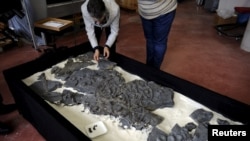One of the enduring mysteries of paleontology, the demise of a highly successful group of dolphin-like marine reptiles called ichthyosaurs that flourished in Earth's seas for more than 150 million years, may finally have been solved.
Scientists on Tuesday attributed the creatures' extinction 94 million years ago to the combination of global warming and their own failure to evolve swiftly enough.
The research, the most comprehensive analysis to date of their disappearance, undercut previous notions that ichthyosaurs had been in decline for tens of millions of years and were no match for competition from other predators, such as the fearsome oceangoing lizards called mosasaurs that were just arriving on the scene.
The study showed that large mosasaurs in fact appeared only after ichthyosaurs went extinct.
"We found ichthyosaurs were very diversified during the last part of their reign," said paleontologist Valentin Fischer of Belgium's University of Liege, noting that several species with various body shapes and ecological niches existed although ichthyosaur evolution had become relatively stagnant.
"We find that the extinction was abrupt, not gradual," added University of Oxford paleontologist Roger Benson.
Streamlined design
Ichthyosaurs arose about 248 million years ago. They became key players in marine ecosystems while dinosaurs ruled the land.
With a streamlined, dolphin-like body design, they were fast, efficient, air-breathing swimmers with muscular flippers and vertical tail flukes like sharks, not horizontal like whales and dolphins.
They possessed unusually large eyes to spot fish, squid and similar prey in deep or turbid waters. They bore live babies rather than laying eggs.
Some measured less than 3 feet (1 meter) long. Others achieved immense size like Shonisaurus, which lived about 210 million years ago and reached about 70 feet (21 meters).
"Shonisaurus was probably the biggest animal that had appeared on Earth up to that point in time," Benson said.
The researchers performed a thorough examination of the ichthyosaur fossil record, reconstructing the group's evolutionary diversity, and scrutinized evidence of climate change coinciding with their extinction.
Earth was warming rapidly, approaching the hottest times of the past 250 million years, triggering strong fluctuations in sea levels and temperatures.
For a time, large swaths of seafloor became depleted in the oxygen necessary for animals to live.
Fischer said these changes likely altered ichthyosaur migratory routes, food availability and birthing places.
Other marine creatures including squid relatives and reef-building clams also suffered major losses.
The research was published in the journal Nature Communications.










